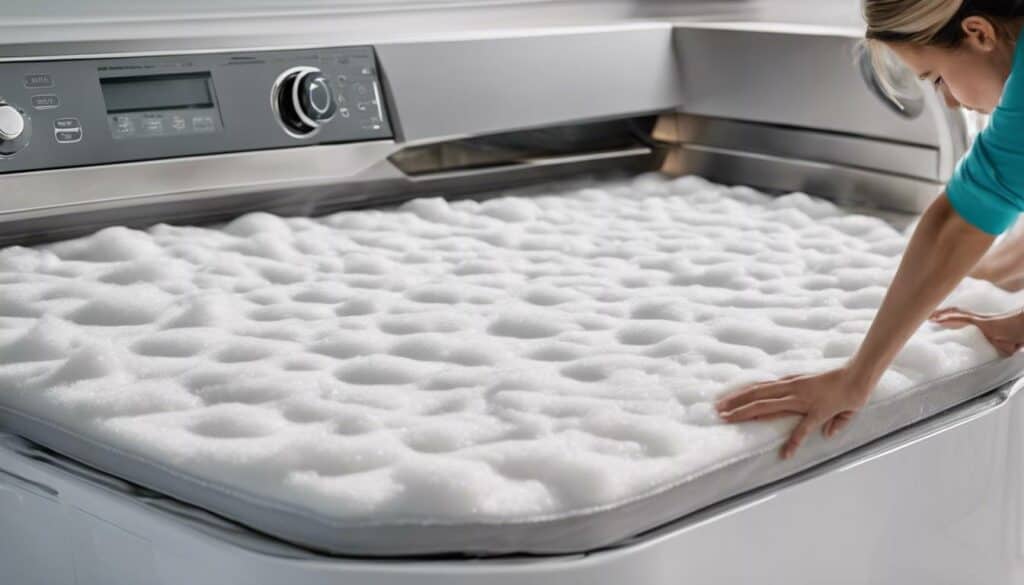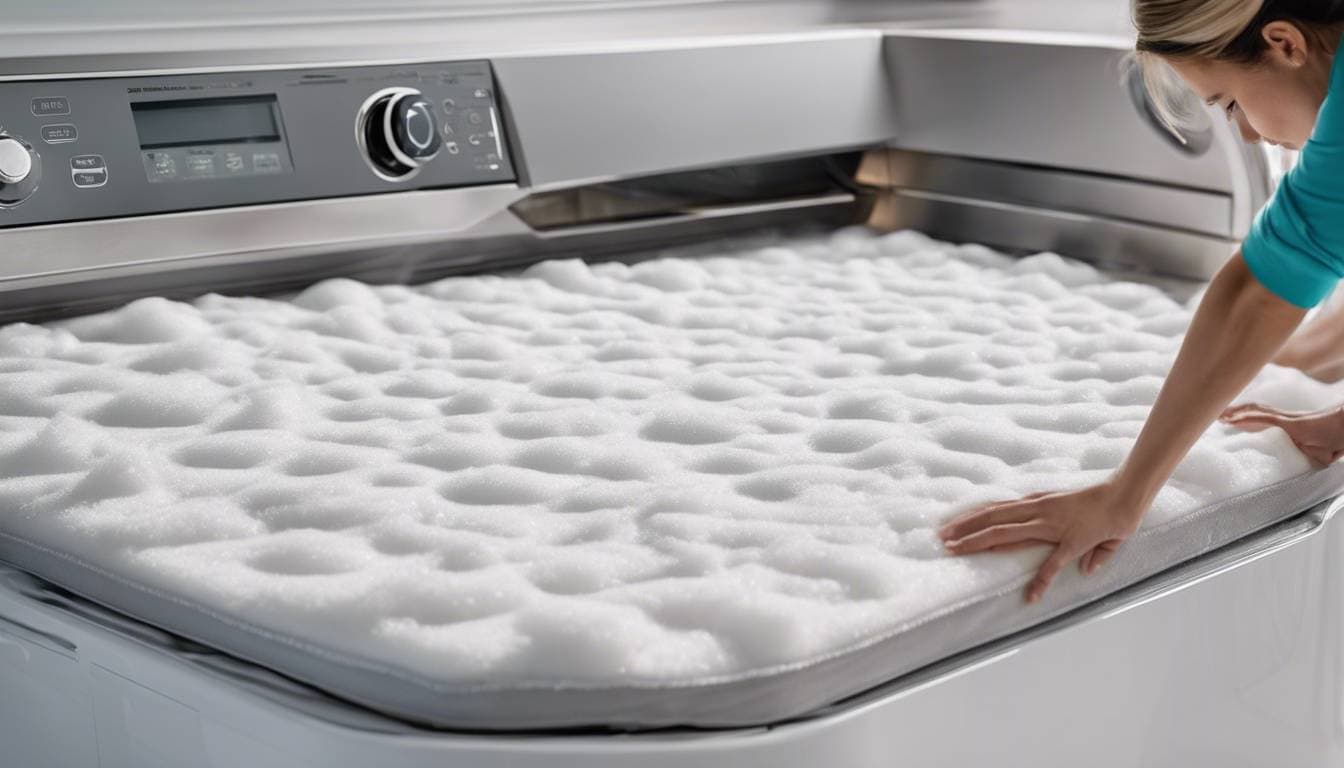No, it is generally not advisable to machine wash foam mattress toppers. The reason being that the delicate structure of the foam can get damaged in a machine wash, leading to loss of shape and support. It’s like trying to clean a fragile flower with a powerful water hose; the strength can cause more harm than good. But don’t worry; there are other gentle ways that can effectively clean your foam mattress topper which doesn’t involve risking its quality. Let’s dive into those methods now.
It is not recommended to machine wash foam mattress toppers, as the delicate structure of the foam can be damaged by the agitation and moisture. Instead, spot clean stains with a borax and water solution and regularly vacuum the topper to remove dust mites and debris for proper maintenance.
Machine vs Hand Washing of Foam Mattress Toppers
Machine washing might seem like a quick and easy solution to clean your foam mattress topper, but it’s essential to know that it can potentially cause damage to the delicate foam structure. The mechanical action and forceful movement inside the washer can lead to loss of shape and support over time. Conversely, hand washing offers a safer approach, allowing for more control over the cleaning process.
When you hand wash a foam mattress topper, you have complete control over the cleaning movements and can ensure that the delicate structure of the foam is not compromised. This method allows for gentler handling, reducing the risk of tearing or deforming the foam. Additionally, hand washing allows you to target specific areas that may require extra attention, such as stains or odors.
Think of it this way: if you were cleaning a fragile glass vase, you wouldn’t toss it into a washing machine, right? The same principle applies to foam mattress toppers—hand washing gives you the precision and care needed to maintain their integrity.
Furthermore, if you’ve invested in a high-quality foam mattress topper to enhance your sleep experience, taking the time to hand wash it will help protect your investment.
While machine washing may seem more convenient, especially for larger items like mattress toppers, it’s clear that when it comes to cleaning foam mattress toppers, hand washing is the superior choice in terms of maintaining their shape and structure.
In light of understanding the intricate details involved in preserving foam mattress toppers, let’s now shift our focus to exploring specific care methods for various types of mattress toppers.
Specifics for Cleaning Different Types of Mattress Toppers
Foam mattress toppers come in various materials such as memory foam, latex foam, and polyfoam, and each type requires different care. Let’s explore how to meticulously and effectively clean each of these mattress toppers according to their specific needs.
Memory Foam Mattress Toppers
Memory foam is a popular choice known for its contouring support and pressure relief. However, it’s particularly sensitive to moisture, making it essential to approach cleaning with caution. While some memory foam mattress toppers are machine washable on a gentle cycle with mild detergent, it’s highly advisable to spot clean or use a handheld vacuum to remove stains and debris. Excessive exposure to water can cause the foam to degrade and affect its performance and lifespan.
Latex Foam Mattress Toppers
Latex foam mattress toppers are valued for their durability and natural resistance to allergens. When it comes to cleaning, they’re not machine washable. Instead, spot clean with mild detergent and water, then allow the topper to air dry properly before placing it back on the bed. This process helps maintain the quality of the latex foam and ensures its longevity.
Polyfoam Mattress Toppers
Polyfoam mattress toppers offer a balance of comfort and support at an affordable price point. For cleaning, always refer to specific care instructions provided by the manufacturer, as some polyfoam mattress toppers may be machine washable while others may require spot cleaning. Following the manufacturer’s guidelines is crucial to preventing damage during the cleaning process.
It’s important to note that regardless of the type of foam mattress topper, certain general guidelines should be followed:
- Avoid using harsh chemicals or bleach-based products.
- Allow the mattress topper to thoroughly air dry before putting it back on your bed.
- Regular vacuuming can help remove dust mites and debris, prolonging the life of the mattress topper.
Understanding the unique care requirements for different types of foam mattress toppers empowers you with tailored cleaning knowledge, ensuring that you can maintain their integrity and performance over time without causing any damage.
Safety Precautions for Washing Foam Mattress Toppers
Before embarking on the task of washing your foam mattress topper, it’s crucial to ensure safety and avoid any potential mishaps. Safety precautions are vital in any cleaning process, but they are especially critical when dealing with large, heavy items like foam mattress toppers.
When it comes to foam mattress toppers, one of the key safety precautions is avoiding the use of harsh chemicals. While it may be tempting to reach for strong cleaning agents to tackle tough stains and odors, these chemicals can harm the delicate structure of the foam. Instead, opt for milder, gentler cleaning solutions specifically formulated for delicate materials.
Proper ventilation during the cleaning process is also crucial. Foam mattress toppers can absorb moisture, which can lead to mold and mildew growth if not properly dried. To prevent this, make sure to clean your mattress topper in a well-ventilated area and allow it to dry completely before using it again.
Additionally, since foam mattress toppers can be quite heavy, it’s essential to lift them carefully to prevent strain or injury. When moving or lifting a foam mattress topper, always ensure that you have proper support and lift with your legs rather than your back. This will not only protect you from potential injury but also prevent damage to the mattress topper itself.
In summary, taking these safety precautions into account will help ensure a safe and effective cleaning process for your foam mattress topper. By using gentle cleaning solutions, ensuring proper ventilation, and carefully lifting heavy toppers, you can maintain the integrity of your mattress topper while safeguarding your own well-being.
With safety at the forefront of our minds, let’s now explore specific techniques for washing foam mattress toppers without compromising their quality.
Techniques for Washing Foam Mattress Toppers
Washing a foam mattress topper calls for gentle care and attention—much like giving your favorite sweater a little TLC. The aim is to clean it without ruining its delicate structure.
Hand Washing Process
When it comes to washing foam mattress toppers, a hands-on approach is often the best practice. Here’s how you can maintain and enjoy your foam mattress topper for years to come:
- Prepare the Cleaning Solution: Create a mixture of mild detergent with cold water.
- Spot Clean Stains: Identify any stained areas on the topper and gently work from the outside edge of the stain toward the center, using a soft cloth or sponge dipped in the cleaning solution.
- Be Gentle: Avoid vigorous rubbing or scrubbing, as this can damage the foam. Instead, use light movements and patience.
- Rinse Carefully: After spot-cleaning, rinse the foam pad with cold water using a clean white cloth or sponge. Gently pat, never twist or wring, to remove excess moisture.
The key here is to remember that foam doesn’t respond well to excessive moisture or aggressive handling. Too much water can permanently compromise the structural integrity of the foam, so minimal exposure is essential.
Remember: Foam mattress toppers should never be machine washed due to the risk of structural damage.
Drying Method
After hand washing, it’s crucial to ensure proper drying:
- Air Dry: Lay the foam mattress topper on a waterproof surface in a well-ventilated area away from direct sunlight.
- Rotate Periodically: Flip or rotate the foam topper occasionally during drying to ensure equal and thorough drying.
While waiting for it to dry might seem inconvenient, remember that this important step ensures that your foam mattress topper will maintain its shape, comfort, and longevity.
It’s evident that cleaning a foam mattress topper demands patience and careful attention, ensuring that every step taken preserves its quality and comfort for years of use.
With a thorough understanding of hand washing techniques for foam mattress toppers, it’s equally important to choose suitable detergents that maintain their quality while cleaning effectively. Let’s now explore the critical aspect of “Detergent Selection for Foam Mattress Toppers”.
Detergent Selection for Foam Mattress Toppers
When cleaning your foam mattress topper, a gentle touch is crucial. Harsh chemicals can damage the delicate material, making your choice of detergent pivotal. It should be mild and free from harsh ingredients that could harm the foam. The right detergent not only helps in maintaining the topper’s appearance but also contributes to its longevity.
So, what exactly constitutes a suitable detergent? Let’s break it down:
Criteria |
Consideration |
|---|---|
pH Level |
A mild detergent with a pH level around 7-8 is ideal. This ensures that it’s not too acidic or alkaline, which can potentially damage the foam. |
Biodegradability |
Look for a detergent with a biodegradability rate of 90% or higher. This indicates that it’s eco-friendly and won’t leave harmful residues on your topper. |
Additive-Free |
Ensure that the detergent is free from bleach, fabric softeners, and strong fragrances as these can be detrimental to the foam material. |
When seeking out a suitable detergent, it’s best to refer to the manufacturer’s recommendations for your specific foam mattress topper. They often provide valuable insights into the type of products that are safe to use.
Recommended by mattress topper manufacturer
For everyday use, a gentle liquid soap can be an effective choice. However, if you prefer using specialized foam cleansers, there are products designed specifically for foam materials such as mattress toppers that offer thorough cleaning without causing any damage.
Additionally, some natural detergents like enzyme-based cleaners are gaining popularity due to their ability to effectively remove stains and odors while being gentle on delicate materials. Nature’s Miracle is one such enzyme cleaner known for its efficacy in cleaning various surfaces, including foam.
To ensure our readers have access to these recommended detergents, we promote the availability of such products on our website for their cleaning needs.
When handling foam mattress toppers, it’s essential to make informed choices about the detergents used in the cleaning process, ensuring both effectiveness and safety for your valuable bedding investment.
As we’ve covered the importance of choosing the right detergent for cleaning foam mattress toppers, let’s now explore proper drying techniques and considerations regarding heat for these delicate bedding essentials.
Drying Techniques and Heat Considerations for Foam Mattress Toppers
When it comes to drying foam mattress toppers, it’s crucial to handle them with care and patience due to their delicate structure. Let’s explore the best practices for drying to ensure your mattress topper stays in prime condition.
First off, it’s essential to emphasize that foam mattress toppers should be air-dried. Exposing them to high heat can cause irreversible damage. The ideal location for drying is outdoors in a shaded area away from direct sunlight. By avoiding the use of dryers or exposing the foam to high heat, you can maintain the integrity of the material.
The reason behind this is simple – foam is sensitive to high temperatures, which can cause it to lose its shape and structural integrity. Additionally, prolonged exposure to direct sunlight can lead to discoloration and degradation of the foam material. Therefore, it’s crucial to prioritize gentle and natural drying methods to preserve the quality of your foam mattress topper.
Proper Air-Drying Procedure:
- Lay the foam mattress topper on a clean and waterproof surface.
- Ensure the topper is positioned away from direct sunlight.
- Regularly fluff and rotate the topper during the drying process to ensure even drying and prevent mildew.
It’s also important to note that the drying time for foam mattress toppers can vary based on their thickness. Thicker toppers may require up to 48 hours for complete drying, while thinner ones may take less time.
Some individuals may be tempted to expedite the drying process using hair dryers or other heat sources. However, this is strongly discouraged as excessive heat can lead to irreversible damage, including warping, shrinking, and deterioration of the foam material.
Risks of Using Heat Sources:
- Warping of the foam material
- Structural damage leading to reduced comfort and support
- Accelerated deterioration of the foam
While it might be tempting to use quick-drying methods, especially if you’re in a rush, consider this – taking a little extra time now to air-dry your foam mattress topper correctly will save you from potential headaches down the road like having a misshapen or damaged topper that requires replacing sooner than expected.
In conclusion, by prioritizing gentle air-drying methods and avoiding exposure to high heat sources, you can ensure that your foam mattress topper maintains its quality and extends its lifespan.
In summary, taking proper care during the drying phase contributes significantly to prolonging the life of your foam mattress topper, ultimately saving you time and money in replacement costs.






